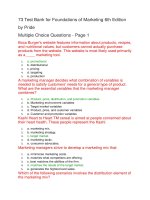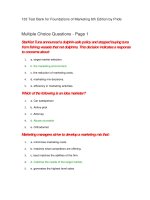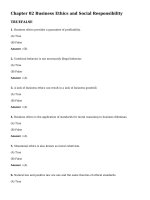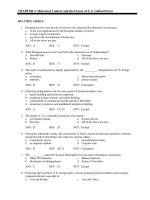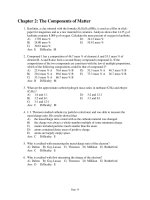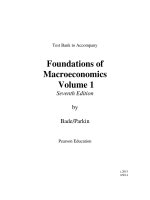Foundations of macroeconomics 6th edition bade test bank
Bạn đang xem bản rút gọn của tài liệu. Xem và tải ngay bản đầy đủ của tài liệu tại đây (485.13 KB, 71 trang )
Foundations of Macroeconomics, 6e (Bade/Parkin)
Chapter 2 The U.S. and Global Economies
2.1 What, How, and For Whom?
1) Items that are purchased by individuals for their own enjoyment are called
A) consumption goods and services.
B) capital goods.
C) government goods and services.
D) exports of goods and services.
E) private goods.
Answer: A
Topic: Consumption goods and services
Skill: Level 1: Definition
Section: Checkpoint 2.1
Status: WM
AACSB: Reflective Thinking
2) Items bought by individuals to provide personal enjoyment are termed
A) consumption goods.
B) personal goods.
C) consumption or investment goods.
D) standard goods.
E) pleasure goods.
Answer: A
Topic: Consumption goods and services
Skill: Level 1: Definition
Section: Checkpoint 2.1
Status: NAU
AACSB: Reflective Thinking
3) What would be an example of consumption good?
A) Antonio, the manager of the local Taco Hut, purchases a new deep fryer.
B) The local driver's license office purchases a new digital camera and printer.
C) Rhianna gets a haircut.
D) Jake buys an iPhone.
E) Donald Trump purchases furniture for his office.
Answer: D
Topic: What we produce
Skill: Level 2: Using definitions
Section: Checkpoint 2.1
Status: KG
AACSB: Reflective Thinking
1
Copyright © 2013 Pearson Education, Inc.
4) Which of the following is a consumption good or service?
A) a personal computer purchased in order to play games at home
B) a United Airline ticket counter
C) the Endeavor space shuttle
D) a United Parcel Service truck delivering Christmas gifts
E) a satellite dish installed by Cox Cable to download programs that are then distributed through
its cable system
Answer: A
Topic: Consumption goods and services
Skill: Level 2: Using definitions
Section: Checkpoint 2.1
Status: CT
AACSB: Reflective Thinking
5) What would be an example of consumption service?
A) Rhianna gets a haircut.
B) Jake buys an iPhone.
C) Antonio, the manager of the local Taco Hut, purchases a new deep fryer.
D) The local driver's license office purchases a new digital camera and printer.
E) Donald Trump purchases furniture for his office.
Answer: A
Topic: Consumption goods and services
Skill: Level 2: Using definitions
Section: Checkpoint 2.1
Status: KG
AACSB: Reflective Thinking
6) The largest share of total production in the United States is
A) consumption goods and services.
B) capital goods.
C) government goods and services.
D) exported goods and services.
E) imported goods and services.
Answer: A
Topic: Consumption goods and services
Skill: Level 1: Definition
Section: Checkpoint 2.1
Status: CT
AACSB: Reflective Thinking
2
Copyright © 2013 Pearson Education, Inc.
7) Items bought by businesses to help produce other goods and services are called
A) consumption goods and services.
B) capital goods.
C) government goods and services.
D) exports of goods and services.
E) productive goods.
Answer: B
Topic: Capital goods
Skill: Level 1: Definition
Section: Checkpoint 2.1
Status: WM
AACSB: Reflective Thinking
8) An item that is purchased to increase businesses' productive resources is
A) an export.
B) a government good.
C) a capital good.
D) a consumption good.
E) a productive good.
Answer: C
Topic: Capital goods
Skill: Level 1: Definition
Section: Checkpoint 2.1
Status: CT
AACSB: Reflective Thinking
9) What would be an example of capital good?
A) Jeanette buys a new dress.
B) The local driver's license office purchases a new digital camera and printer.
C) Antonio, the manager of the local Taco Hut, purchases a new deep fryer.
D) Apple sells computers to Japan.
E) Rhianna gets a haircut.
Answer: C
Topic: Capital goods
Skill: Level 2: Using definitions
Section: Checkpoint 2.1
Status: KG
AACSB: Reflective Thinking
3
Copyright © 2013 Pearson Education, Inc.
10) The difference between consumption and capital goods is that
A) only big corporations can afford capital goods.
B) capital goods are used to produce additional goods while consumption goods are not.
C) capital goods are provided by the government.
D) consumption goods can be enjoyed by many people at the same time.
E) it is illegal to export capital goods.
Answer: B
Topic: Consumption and capital goods
Skill: Level 1: Definition
Section: Checkpoint 2.1
Status: DMC
AACSB: Reflective Thinking
11) Goods and services bought by the government account for about ________ percent of total
production.
A) 2
B) 8
C) 17
D) 35
E) 67
Answer: C
Topic: Government goods and services
Skill: Level 1: Definition
Section: Checkpoint 2.1
Status: NAU
AACSB: Reflective Thinking
12) What would be an example of government good?
A) Jake buys an iPhone.
B) The local driver's license office purchases a new digital camera and printer.
C) Antonio, the manager of the local Taco Hut, purchases a new deep fryer.
D) Donald Trump purchases furniture for his office.
E) Rhianna gets a haircut.
Answer: B
Topic: Government goods and services
Skill: Level 2: Using definitions
Section: Checkpoint 2.1
Status: KG
AACSB: Reflective Thinking
4
Copyright © 2013 Pearson Education, Inc.
13) Goods produced in the United States and sold in other countries are called
A) exports.
B) imports.
C) foreign goods.
D) capital goods.
E) capital account goods.
Answer: A
Topic: Exports
Skill: Level 1: Definition
Section: Checkpoint 2.1
Status: NAU
AACSB: Reflective Thinking
14) An export good is a good produced
A) in the United States and sold to foreigners living in the United States.
B) by foreigners in the United States and purchased by U.S. households.
C) in another country and purchased by U.S. residents.
D) in the United States and sold in other countries.
E) in another country and purchased by foreigners not residing in the United States.
Answer: D
Topic: Exports
Skill: Level 1: Definition
Section: Checkpoint 2.1
Status: DMC
AACSB: Reflective Thinking
15) Computers and insurance coverage produced in the United States and sold to people in other
nations are categorized as
A) U.S. consumption goods and services.
B) foreign capital goods.
C) U.S. government goods and services.
D) U.S. exports of goods and services.
E) U.S. imports of goods and services.
Answer: D
Topic: Exports
Skill: Level 2: Using definitions
Section: Checkpoint 2.1
Status: AA
AACSB: Reflective Thinking
5
Copyright © 2013 Pearson Education, Inc.
16) The Colorado Ski Shop sold 60 ski jackets to a Belgium company's headquarters located in
Paris, France. The ski jackets are a
A) U.S. export good.
B) capital good.
C) government good.
D) U.S. consumption service.
E) U.S. import.
Answer: A
Topic: Exports
Skill: Level 2: Using definitions
Section: Checkpoint 2.1
Status: CT
AACSB: Reflective Thinking
17) Over the past 70 years, which of the following has occurred?
i) The service sector has grown so that now about 80 percent of workers are now employed in
the service industry.
ii) The manufacturing sector has shrunk, so now about 20 percent of workers are now employed
in the production of goods.
iii) The percentage of workers employed in the service industry has increased steadily.
A) i, ii and iii
B) i and iii
C) ii only
D) i only
E) ii and iii
Answer: A
Topic: Changes in what we produce
Skill: Level 2: Using definitions
Section: Checkpoint 2.1
Status: New
AACSB: Reflective Thinking
18) Which of the following is not considered one of the factors of production?
A) land
B) labor
C) capital
D) technology
E) entrepreneurship
Answer: D
Topic: Factors of production
Skill: Level 1: Definition
Section: Checkpoint 2.1
Status: KG
AACSB: Reflective Thinking
6
Copyright © 2013 Pearson Education, Inc.
19) Which of the following correctly lists the categories of factors of production?
A) land, labor, capital, and entrepreneurship
B) land, buildings, capital, and entrepreneurship
C) labor, machines, buildings, capital, and entrepreneurship
D) forests, fish, buildings, capital, and entrepreneurship
E) labor, money, stocks, and bonds
Answer: A
Topic: Factors of production
Skill: Level 1: Definition
Section: Checkpoint 2.1
Status: AA
AACSB: Reflective Thinking
20) Goods and services are produced by using four factors of production:
A) land, labor, capital, and entrepreneurship.
B) land, labor, money, and equipment.
C) natural resources, human resources, financial assets, and entrepreneurial resources.
D) labor, human capital, physical capital, and financial capital.
E) land, labor, capital, and money.
Answer: A
Topic: Factors of production
Skill: Level 1: Definition
Section: Checkpoint 2.1
Status: CO
AACSB: Reflective Thinking
21) Factors of production are the
A) goods that are bought by individuals and used to provide personal enjoyment.
B) goods that are bought by businesses to produce productive resources.
C) productive resources used to produce goods and services.
D) productive resources used by government to increase the productivity of consumption.
E) goods and services produced by the economy.
Answer: C
Topic: Factors of production
Skill: Level 1: Definition
Section: Checkpoint 2.1
Status: CT
AACSB: Reflective Thinking
7
Copyright © 2013 Pearson Education, Inc.
22) The productive resource that includes all the "gifts of nature" is called
A) land.
B) labor.
C) capital.
D) entrepreneurship.
E) land if undeveloped and capital if developed.
Answer: A
Topic: Land
Skill: Level 1: Definition
Section: Checkpoint 2.1
Status: WM
AACSB: Reflective Thinking
23) Economists classify energy and water as part of which factor of production?
A) land
B) labor
C) capital
D) entrepreneurship
E) land if undeveloped and capital if developed
Answer: A
Topic: Land
Skill: Level 2: Using definitions
Section: Checkpoint 2.1
Status: CT
AACSB: Reflective Thinking
24) As a factor of production, oil reserves are counted as
A) land.
B) labor.
C) capital.
D) entrepreneurship.
E) financial capital.
Answer: A
Topic: Land
Skill: Level 2: Using definitions
Section: Checkpoint 2.1
Status: NAU
AACSB: Reflective Thinking
8
Copyright © 2013 Pearson Education, Inc.
25) Over time, the percentage of total employment in services has ________ and in agriculture,
employment has ________.
A) increased; increased
B) decreased; increased
C) stayed about the same; decreased
D) stayed about the same; increased
E) increased; decreased
Answer: E
Topic: Labor
Skill: Level 1: Definition
Section: Checkpoint 2.1
Status: KG
AACSB: Reflective Thinking
26) The concept of human capital describes
A) human skills, that is, the quality of labor.
B) human population, that is, the quantity of labor.
C) the number of machines per employed worker.
D) the number of workers per operating machine.
E) the number of machines (capital) that have been produced by people (humans).
Answer: A
Topic: Human capital
Skill: Level 1: Definition
Section: Checkpoint 2.1
Status: DMC
AACSB: Reflective Thinking
27) Which factor of production does human capital enhance?
i. land
ii. labor
iii. capital
A) i only
B) ii only
C) iii only
D) i and ii
E) i, ii, and iii
Answer: B
Topic: Labor, human capital
Skill: Level 2: Using definitions
Section: Checkpoint 2.1
Status: TPS
AACSB: Reflective Thinking
9
Copyright © 2013 Pearson Education, Inc.
28) Human capital can be increased through
A) investment in new technology.
B) education, on-the-job training, and work experience.
C) investment in new machinery.
D) decreases in population.
E) increasing the nation's production of consumption goods.
Answer: B
Topic: Human capital
Skill: Level 1: Definition
Section: Checkpoint 2.1
Status: DMC
AACSB: Reflective Thinking
29) The United States possesses a large amount of human capital. As a result of this fact, in the
United States there is a
A) large amount of machinery and equipment.
B) large number of people and a great deal of land.
C) highly skilled and educated labor force.
D) large number of kind and generous humans.
E) large amount of machinery (capital) that is run by people (humans).
Answer: C
Topic: Labor, human capital
Skill: Level 2: Using definitions
Section: Checkpoint 2.1
Status: AA
AACSB: Reflective Thinking
30) Jan is attending college and studying to be an investment broker. To improve her chances of
employment following college, she has interned at a top brokerage firm during the last two
summers. Jan's internship has increased her
A) natural labor.
B) human capital.
C) consumption services.
D) natural resources.
E) entrepreneurship capital.
Answer: B
Topic: Labor, human capital
Skill: Level 4: Applying models
Section: Checkpoint 2.1
Status: CT
AACSB: Reflective Thinking
10
Copyright © 2013 Pearson Education, Inc.
31) Human capital ________ as you work. As a result, the ___________ of goods and services
________.
A) increases; quantity; increases.
B) declines; quality; increases.
C) improves; quality; does not change.
D) does not change; quality; does not change.
E) decreases; quantity; decreases.
Answer: A
Topic: Human capital
Skill: Level 2: Using definitions
Section: Checkpoint 2.1
Status: New
AACSB: Reflective Thinking
32) Capital, as a factor of production, refers to
A) money, stocks, and bonds.
B) the production technology used by firms.
C) the tools and instruments used to produce other goods and services.
D) the production factors imported from abroad.
E) stocks and bonds but not money.
Answer: C
Topic: Capital
Skill: Level 1: Definition
Section: Checkpoint 2.1
Status: DMC
AACSB: Reflective Thinking
33) The total value of capital in the United States is around
A) $50 trillion.
B) $10 trillion.
C) $79 trillion.
D) $100 trillion.
E) $145 trillion.
Answer: A
Topic: Capital
Skill: Level 1: Definition
Section: Checkpoint 2.1
Status: NAU
AACSB: Reflective Thinking
11
Copyright © 2013 Pearson Education, Inc.
34) Capital is a factor of production. Which of the following is an example of capital?
i. $1,000 in money
ii. 100 shares of Microsoft stock
iii. $10,000 in bonds issued by General Motors
iv. a drill press in your local machine shop
A) i and ii
B) ii only
C) iii only
D) iv only
E) ii and iii
Answer: D
Topic: Capital
Skill: Level 1: Definition
Section: Checkpoint 2.1
Status: TPS
AACSB: Reflective Thinking
35) Capital is a factor of production. An example of capital as a factor of production is
A) money.
B) stocks.
C) bonds.
D) machines.
E) education.
Answer: D
Topic: Capital
Skill: Level 1: Definition
Section: Checkpoint 2.1
Status: CT
AACSB: Reflective Thinking
36) One of the productive resources is capital. Capital includes
A) money borrowed from a bank.
B) a company's stocks and bonds.
C) tools, buildings, and machine tools.
D) toys, t-shirts, CD players, and pencils.
E) money in a savings account at a bank.
Answer: C
Topic: Capital
Skill: Level 1: Definition
Section: Checkpoint 2.1
Status: AA
AACSB: Reflective Thinking
12
Copyright © 2013 Pearson Education, Inc.
37) Which of the following is NOT considered capital?
A) an assembly line at a General Motors plant
B) a computer used by your instructor for presentations in class
C) stocks and bonds that are sold by Pepsico
D) the furniture in the President's office
E) a nail gun used for building houses
Answer: C
Topic: How do we produce?
Skill: Level 1: Definition
Section: Checkpoint 2.1
Status: KG
AACSB: Reflective Thinking
38) Entrepreneurship, as a factor of production, refers to
A) the technology used by firms.
B) the human capital accumulated by workers.
C) the value of the firm's stock.
D) the human resource that organizes labor, land, and capital.
E) the capital the firm uses.
Answer: D
Topic: Entrepreneurship
Skill: Level 1: Definition
Section: Checkpoint 2.1
Status: DMC
AACSB: Reflective Thinking
39) The productive resource that organizes labor, land, and capital is
A) human capital.
B) financial capital.
C) entrepreneurship.
D) government.
E) capital.
Answer: C
Topic: Entrepreneurship
Skill: Level 1: Definition
Section: Checkpoint 2.1
Status: WM
AACSB: Reflective Thinking
13
Copyright © 2013 Pearson Education, Inc.
40) Payments to the factors of production are
A) rent, mortgage, interest, and bonds.
B) rent, interest, bonds, and profit or loss.
C) rent, wages, interest, and profit or loss.
D) rent, wages, profit or loss, and bonus.
E) land, labor, capital, and entrepreneurship.
Answer: C
Topic: Resource payments
Skill: Level 1: Definition
Section: Checkpoint 2.1
Status: AA
AACSB: Reflective Thinking
41) ________ paid for the use of land; ________ paid for the services of labor; and ________
paid for the use of capital.
A) Rent is; wages are; interest is
B) Rent is; interest is; wages are
C) Interest is; wages are; profit is
D) Mortgages are; interest is; wages are
E) Rent is; wages are; profit is
Answer: A
Topic: Resource payments
Skill: Level 2: Using definitions
Section: Checkpoint 2.1
Status: DMC
AACSB: Reflective Thinking
42) The income paid for the use of land is called
A) rent.
B) wages.
C) interest.
D) profit.
E) land capital.
Answer: A
Topic: Resource payments
Skill: Level 1: Definition
Section: Checkpoint 2.1
Status: CT
AACSB: Reflective Thinking
14
Copyright © 2013 Pearson Education, Inc.
43) The income paid to labor is called
A) rent.
B) wages.
C) interest.
D) profit.
E) human capital.
Answer: B
Topic: Resource payments
Skill: Level 1: Definition
Section: Checkpoint 2.1
Status: CT
AACSB: Reflective Thinking
44) Which factor of production is paid "interest"?
A) land
B) labor
C) capital
D) entrepreneurship
E) human capital
Answer: C
Topic: Resource payments
Skill: Level 1: Definition
Section: Checkpoint 2.1
Status: TPS
AACSB: Reflective Thinking
45) The owners of the resource ________ are paid ________ .
A) land; wages
B) labor; profit
C) capital; rent
D) capital; interest
E) entrepreneurship; wages
Answer: D
Topic: Resource payments
Skill: Level 2: Using definitions
Section: Checkpoint 2.1
Status: AA
AACSB: Reflective Thinking
15
Copyright © 2013 Pearson Education, Inc.
46) Which factor of production is paid "profit"?
A) land
B) labor
C) capital
D) entrepreneurship
E) human capital
Answer: D
Topic: Resource payments
Skill: Level 1: Definition
Section: Checkpoint 2.1
Status: TPS
AACSB: Reflective Thinking
47) The functional distribution of income measures which of the following?
A) How federal tax revenues are related to the business function that employs taxpayers.
B) The distribution of earnings by the factors of production.
C) The proportion of income generated by the four types of expenditures on goods and services.
D) The distribution of income among households.
E) The distribution of income among nations.
Answer: B
Topic: Functional distribution of income
Skill: Level 1: Definition
Section: Checkpoint 2.1
Status: TPS
AACSB: Reflective Thinking
48) In the United States, the productive factor that, as a group, receives the largest fraction of the
nation's total income was
A) labor.
B) capital.
C) consumption goods and services.
D) entrepreneurship.
E) land.
Answer: A
Topic: Functional distribution of income
Skill: Level 1: Definition
Section: Checkpoint 2.1
Status: CT
AACSB: Reflective Thinking
16
Copyright © 2013 Pearson Education, Inc.
49) According to the functional distribution of income, in the United States
A) capital earns most of the income.
B) labor earns most of the income.
C) land earns most of the income.
D) entrepreneurs earned most of the income.
E) the income earned by capital and labor are approximately equal.
Answer: B
Topic: Functional distribution of income
Skill: Level 1: Definition
Section: Checkpoint 2.1
Status: DMC
AACSB: Reflective Thinking
50) The data show that more than 60 percent of the total income earned in the United States goes
to
A) labor.
B) land.
C) capital.
D) entrepreneurship.
E) profit.
Answer: A
Topic: Functional distribution of income
Skill: Level 1: Definition
Section: Checkpoint 2.1
Status: AA
AACSB: Reflective Thinking
51) The majority of the income earned in the United States is paid in
A) rent.
B) wages.
C) interest.
D) profit.
E) dividends.
Answer: B
Topic: Functional distribution of income
Skill: Level 2: Using definitions
Section: Checkpoint 2.1
Status: KG
AACSB: Reflective Thinking
17
Copyright © 2013 Pearson Education, Inc.
52) The personal distribution of income measures which of the following?
A) How federal tax revenues are related to the type of businesses that employs the taxpayers
B) The distribution of earnings by the factors of production
C) Proportion of income generated by the four types of expenditures on goods and services
D) The distribution of income among households
E) The distribution of income among nations
Answer: D
Topic: Personal distribution of income
Skill: Level 1: Definition
Section: Checkpoint 2.1
Status: TPS
AACSB: Reflective Thinking
53) In the United States, the poorest 20 percent of households earn roughly ________ percent of
total income.
A) 20
B) 10
C) 15
D) 3
E) 0.5
Answer: D
Topic: Personal distribution of income
Skill: Level 1: Definition
Section: Checkpoint 2.1
Status: NAU
AACSB: Reflective Thinking
54) The personal distribution of income in the United States shows that
A) income is equally distributed.
B) the poorest 20 percent of individuals receive approximately 20 percent of total income.
C) the richest 20 percent of individuals receive approximately 50 percent of total income.
D) the poorest 60 percent of individuals receive approximately 50 percent of total income.
E) the richest 20 percent of individuals receive approximately 25 percent of total income.
Answer: C
Topic: Personal distribution of income
Skill: Level 3: Using models
Section: Checkpoint 2.1
Status: WM
AACSB: Reflective Thinking
18
Copyright © 2013 Pearson Education, Inc.
55) The richest 20 percent of individuals in the United States receive about ________ of the
nation's total income.
A) 21 percent
B) 51 percent
C) 91 percent
D) 99 percent
E) 23 percent
Answer: B
Topic: Personal distribution of income
Skill: Level 1: Definition
Section: Checkpoint 2.1
Status: AA
AACSB: Reflective Thinking
56) When the total U.S. production of goods and services is divided into consumption goods and
services, capital goods, government goods and services, and export goods and services, the
largest component is
A) consumption goods and services.
B) capital goods.
C) government goods and services.
D) export goods and services.
E) capital goods and government goods and services tie for the largest component.
Answer: A
Topic: What we produce
Skill: Level 2: Using definitions
Section: Checkpoint 2.1
Status: STUDY GUIDE
AACSB: Reflective Thinking
57) An example of a capital good is
A) a fiber optic cable TV system.
B) an insurance policy.
C) a hair cut.
D) an iPod.
E) a slice of pizza.
Answer: A
Topic: What we produce
Skill: Level 2: Using definitions
Section: Checkpoint 2.1
Status: STUDY GUIDE
AACSB: Reflective Thinking
19
Copyright © 2013 Pearson Education, Inc.
58) Goods and services produced in the United States and sold in other countries are called
A) consumption goods and services.
B) capital goods.
C) government goods and services.
D) export goods and services.
E) import goods and services.
Answer: D
Topic: What we produce
Skill: Level 2: Using definitions
Section: Checkpoint 2.1
Status: STUDY GUIDE
AACSB: Reflective Thinking
59) Which of the following correctly lists the categories of factors of production?
A) machines, buildings, land, and money
B) hardware, software, land, and money
C) capital, money, and labor
D) owners, workers, and consumers
E) land, labor, capital, and entrepreneurship
Answer: E
Topic: Factors of production
Skill: Level 1: Definition
Section: Checkpoint 2.1
Status: STUDY GUIDE
AACSB: Reflective Thinking
60) In economics, the factor of production "land" includes all of the following EXCEPT
________.
A) energy
B) plastics
C) wild plants
D) animals, birds, and fish
E) oil
Answer: B
Topic: Land
Skill: Level 2: Using definitions
Section: Checkpoint 2.1
Status: MyEconLab Web Site
AACSB: Reflective Thinking
20
Copyright © 2013 Pearson Education, Inc.
61) Human capital is
A) solely the innate ability we are born with.
B) the money humans have saved.
C) the knowledge humans accumulate through education and experience.
D) machinery that needs human supervision.
E) any type of machinery.
Answer: C
Topic: Human capital
Skill: Level 1: Definition
Section: Checkpoint 2.1
Status: STUDY GUIDE
AACSB: Reflective Thinking
62) When Ethan continues his education beyond high school he is increasing his
A) capital.
B) wage rate.
C) human capital.
D) quantity of labor.
E) rent.
Answer: C
Topic: Human capital
Skill: Level 2: Using definitions
Section: Checkpoint 2.1
Status: MyEconLab Web Site
AACSB: Reflective Thinking
63) ________ is the human resource that organizes labor, land, and capital.
A) Human capital
B) Human skill
C) A gift of nature
D) Entrepreneurship
E) Profit
Answer: D
Topic: Entrepreneurship
Skill: Level 2: Using definitions
Section: Checkpoint 2.1
Status: MyEconLab Web Site
AACSB: Reflective Thinking
21
Copyright © 2013 Pearson Education, Inc.
64) Wages are paid to ________ and interest is paid to ________.
A) entrepreneurs; capital
B) labor; capital
C) labor; land
D) entrepreneurs; land
E) labor; entrepreneurs
Answer: B
Topic: Payments for the factors of production
Skill: Level 1: Definition
Section: Checkpoint 2.1
Status: STUDY GUIDE
AACSB: Reflective Thinking
65) The income earned by entrepreneurs is
A) interest.
B) wages.
C) profit or loss.
D) rent, wages, and interest.
E) a mixture of rent, wages, interest, and profit.
Answer: C
Topic: Profit
Skill: Level 1: Definition
Section: Checkpoint 2.1
Status: MyEconLab Web Site
AACSB: Reflective Thinking
66) Dividing the nation's income among the factors of production, the largest percentage is paid
to
A) labor.
B) land.
C) capital.
D) entrepreneurship.
E) labor and capital, with each receiving about 41 percent of the total income.
Answer: A
Topic: Functional distribution of income
Skill: Level 1: Definition
Section: Checkpoint 2.1
Status: STUDY GUIDE
AACSB: Reflective Thinking
22
Copyright © 2013 Pearson Education, Inc.
67) ________ earned the highest amount of income among the factors of production in the
United States.
A) Labor
B) Capital
C) Land
D) Entrepreneurship
E) Investment
Answer: A
Topic: Functional distribution of income
Skill: Level 1: Definition
Section: Checkpoint 2.1
Status: MyEconLab Web Site
AACSB: Reflective Thinking
68) In the United States, the richest 20 percent of households receive about ________ percent of
total income.
A) 4
B) 15
C) 23
D) 50
E) 33
Answer: D
Topic: Personal distribution of income
Skill: Level 1: Definition
Section: Checkpoint 2.1
Status: MyEconLab Web Site
AACSB: Reflective Thinking
69) In the United States, the poorest 20 percent of households receive about ________ percent of
total income.
A) 3
B) 15
C) 23
D) 49
E) 20
Answer: A
Topic: Personal distribution of income
Skill: Level 1: Definition
Section: Checkpoint 2.1
Status: MyEconLab Web Site
AACSB: Reflective Thinking
23
Copyright © 2013 Pearson Education, Inc.
70) The personal distribution of income shows
A) that labor receives the largest percentage of total income.
B) how profit accounts for the largest fraction of total income.
C) that the richest 20 percent of households receive 23 percent of total income.
D) that interest accounts for most of the income of the richest 20 percent of households.
E) that the poorest 20 percent of households receive less than 4 percent of total income.
Answer: E
Topic: Personal distribution of income
Skill: Level 1: Definition
Section: Checkpoint 2.1
Status: STUDY GUIDE
AACSB: Reflective Thinking
2.2 The Global Economy
1) Compared to the world, the rate of U.S. population growth is
A) slower than in the world as a whole.
B) about the same as in the world as a whole.
C) much faster than in the world as a whole.
D) incomparable because U.S. residents are born with a much greater chance of accumulating a
lot of human capital.
E) incomparable because we do not have accurate world population statistics.
Answer: A
Topic: World population
Skill: Level 1: Definition
Section: Checkpoint 2.2
Status: WM
AACSB: Reflective Thinking
2) Approximately ________ people live in the United States and ________ people live in the
world.
A) 410 million; 8 billion
B) 310 million; 7 billion
C) 210 million; 5 billion
D) 310 million; 3 billion
E) 210 million; 6 billion
Answer: B
Topic: The people
Skill: Level 1: Definition
Section: Checkpoint 2.2
Status: Revised
AACSB: Reflective Thinking
24
Copyright © 2013 Pearson Education, Inc.
3) The most people live in ________ economies and the fewest people live in ________
economies.
A) developing; emerging market
B) advanced; emerging market
C) advanced; developing
D) emerging market; developing
E) developing; advanced
Answer: A
Topic: The countries
Skill: Level 1: Definition
Section: Checkpoint 2.2
Status: KG
AACSB: Reflective Thinking
4) When describing the IMF broad country classification, the most accurate statement is that
A) the category with the greatest number of countries is the advanced economies.
B) the emerging market economies are countries that were, until the early 1990s, part of the
Soviet Union or its satellites.
C) most of the nations in Western Europe are considered emerging market economies.
D) most of the world's population lives in advanced economies.
E) about 50 percent of the world's population live in the advanced economies and the other 50
percent live in the emerging market and developing economies.
Answer: B
Topic: Classification of economies
Skill: Level 1: Definition
Section: Checkpoint 2.2
Status: WM
AACSB: Reflective Thinking
5) Which of the following is NOT classified as an advanced economy?
A) South Korea
B) Australia
C) Russia
D) Hong Kong
E) the United Kingdom
Answer: C
Topic: Advanced economies
Skill: Level 2: Using definitions
Section: Checkpoint 2.2
Status: NAU
AACSB: Reflective Thinking
25
Copyright © 2013 Pearson Education, Inc.
